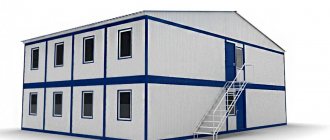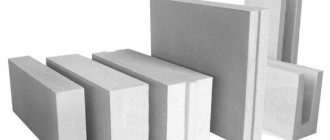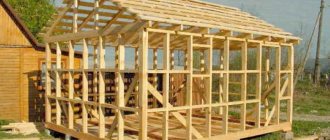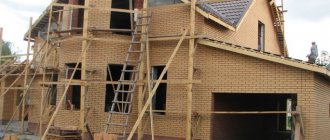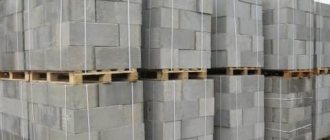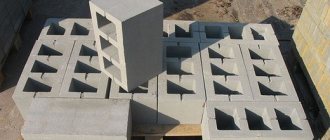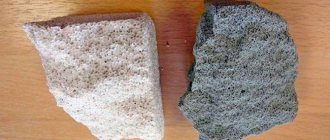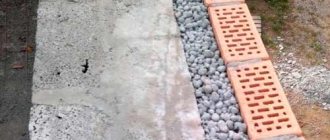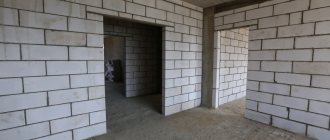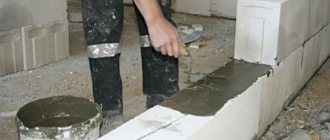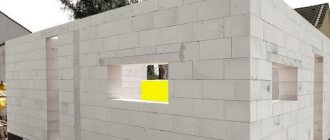Foam blocks
Foam block is a building material, the production of which occurs by mixing cement mortar, sand and water with the addition of special foam (foam concrete). After receiving the mass, it is poured into special molds and cools under natural conditions.
There are several types of foam blocks:
- Structural. They are characterized by maximum reliability, but have low insulating properties. Used in the construction of walls and interior partitions.
- Thermal insulation. It has low strength and is used as insulation.
- Structural and thermal insulation . A combination of two types of blocks. Used as a “warm” material.
Advantages:
- They have low thermal conductivity. Concrete using foam will be much “warmer” than brick. This structure also has good insulating properties.
- Fire safety. The material does not smolder, does not burn and does not release toxins when exposed to fire.
- Frost resistance. They are resistant to sudden temperature changes.
- Easy to install. Foam blocks are easy to machine, which allows you to implement different design solutions.
- Quick installation. The blocks are larger than standard bricks. Accordingly, less of them will be required and less time will be spent.
- Economical. Foamed concrete in most cases will cost less than other building materials.
Flaws:
- Shrinkage. Wasting a lot of time waiting for the building to shrink. The long process can take about two months.
- Low moisture absorption.
- Fragility. If made poorly, the blocks may break or crack.
- Appearance. Dark gray blocks don't look very attractive.
Foam blocks are a durable building material. The approximate service life is 150 years.
The best gypsum tongue-and-groove building blocks
In design, the category nominees resemble a regular parallelepiped with ridges and grooves on opposite sides. They are produced hollow and solid. The first ones are used for the construction of partitions in apartments and private houses. The weight of the latter is 25% more; they are chosen for the construction of walls of public and work buildings. The advantages include low weight, the ability to operate in any climatic conditions, environmental friendliness, ease of installation, high strength, noise insulation and corrosion resistance. The main disadvantage is the high price. According to comparative tests, the leading positions among 10 nominees were occupied by 3 types of blocks.
KNAUF
The thickness of the nominee is 80 mm, and the size is 667x500 mm, so its shape resembles a rectangular parallelepiped with a tongue-and-groove joint. The block has increased moisture resistance, which allows it to be used when constructing partitions in rooms with humidity up to 60%. This is due to the addition of special additives to the molding mass, which reduce water absorption.
Advantages
- The quality of the front surface eliminates the need for plastering;
- The surface is suitable for painting, tiling, wallpapering;
- High degree of fire resistance;
- The composition contains no toxic components;
- Easily machined;
- Does not conduct electric current.
Flaws
- Low strength;
- High price.
Users are attracted by the significant savings in internal space and ease of installation. At the same time, experts advise taking into account that such slabs cannot be used for load-bearing structures, since gypsum is easily destroyed under the influence of linear dynamic loads. The partition must be fixed to the floor and ceiling. The disadvantages include low noise insulation.
We advise you to study - How to choose aluminum radiators
Magma
The nominee is a monolithic slab with a tongue-and-groove joint, the dimensions of which are identical to the parameters of the previous nominee. The density of the material is 982 kg/m3, the compressive strength is 7.2 MPa, and the bending strength is 3.7 MPa. Such indicators indicate the possibility of using the slab for non-load-bearing walls, partitions and cladding in rooms with low humidity levels.
Advantages
- Retains heat well;
- Provides a good indoor microclimate;
- No toxic substances in the composition;
- Does not burn;
- There are no toxic substances in the composition;
- Easy to process.
Flaws
- Low moisture resistance;
- The need for careful fastening to the ceiling.
The smooth surface eliminates the need for plastering, so after erecting the partition, you can immediately cover it with wallpaper or paint it. At the same time, users note that walls made of this material conduct sound well.
The best jackhammers
Volma
The shape and dimensions of the tongue-and-groove slab are identical to the parameters of the previous nominees. Its density does not exceed 1250 kg/m3, but its compressive strength is only 5 MPa, so it is not able to withstand heavy loads. It is used only for the construction of inter-apartment partitions. During manufacturing, hydrophobic additives are added, which reduces the water absorption coefficient of the material to 5%.
Advantages
- Exact geometric dimensions;
- Ease of installation;
- Health safety;
- Does not burn;
- Light weight;
- Reducing construction time.
Flaws
- High price when compared with concrete building blocks;
- Risk of destruction of the partition when the slab shrinks.
Users confirm the simplicity and convenience of constructing structures. Due to special additives in the composition, the partitions absorb less moisture, which significantly increases their service life.
Gas blocks
Aerated concrete is a lightweight cellular concrete that has closed pores throughout its entire diameter. Manufacturing occurs by mixing lime, quartz sand, cement, water and aluminum powder. After mixing, all components are foamed in an autoclave, and a porous material is obtained.
Types of aerated concrete blocks, differing in density:
- thermal insulation;
- structural – thermal insulation;
- structural.
Advantages:
- Low cost.
- Environmentally friendly material. The composition contains only natural ingredients.
- Easy to install, as in the case of using foam blocks.
- The material does not burn, which makes it fireproof.
- High strength. Allows the construction of load-bearing structures.
- A light weight.
- Good thermal insulation and sound insulation. Considering this, spending on additional insulation can be avoided.
- Frost resistance.
Flaws:
- Aerated concrete blocks are fragile. In case of poor installation, the material may crack.
- The need to finish the house, as aerated concrete quickly absorbs moisture from the environment.
- Difficulty in finishing; materials and mixtures do not adhere well to the coating.
- The need to purchase special mixtures.
The approximate service life of aerated concrete is 60 years.
Lightweight concrete blocks for external and internal walls
Lightweight concrete comes in two types. One uses low weight aggregate, which reduces the weight of the building stone or block. In the second, the weight is reduced due to porosity - the cement foams and hardens in this state. In both cases, the weight of the building material becomes significantly lower, and the thermal and sound insulation characteristics are higher.
The characteristics will show which blocks are better for building a house
Aerated concrete blocks
Aerated concrete is a cement-sand mixture to which dry reagents are added to form foam. When water is added, the reagents react with cement laitance and active foaming begins. After increasing the volume, the solution is laid out in molds and allowed to mature. As a result, aerated concrete consists of thin concrete shells that contain air. That is, the block turns out to be light and warm, vapor permeable. He is not afraid of water, but he “pulls” it solidly. So you need good waterproofing of the foundation and you shouldn’t delay the finishing.
Which blocks are best for building a house? Consider the foam block
Advantages and disadvantages
With fairly large dimensions (length 600 mm, height 200 mm, width - from 150 mm to 400 mm), the standard block weighs little. The exact weight varies by brand, but medium density can be worked with alone. For example, let’s say that the weight of an M400 wall block with a thickness of 200 mm is about 13 kg, and a wall block with a thickness of 250 mm is about 17 kg.
Which gas block is best for building a house? Autoclaved aerated concrete
There are two technologies for the production of aerated concrete blocks. One by one, the solution is laid out into molds of a given size and then used. The second method is to make large blocks, and then cut them into smaller ones. The peculiarity of the second technology is that it allows you to maintain dimensions with high accuracy. This makes it possible to use not a masonry mortar made of cement and sand, but a special glue. It can be laid in a very thin layer - literally a couple of millimeters. For what? Yes, because the solution and the same glue have thermal insulation characteristics much worse than those of aerated concrete. And thin seams reduce heat loss. But glue is expensive, so this increases the cost of construction. But you can save on insulation.
| Advantages of aerated concrete | Disadvantages of aerated concrete blocks |
| Precise geometry, which speeds up laying and allows the use of special glue in a very thin layer to improve the thermal properties of the wall. | Glue is expensive, this increases the cost of construction |
| Easy to process. Can be cut with a hacksaw | Reinforcement is required to increase the strength of walls |
| Vapor conductive material | Exterior finishing should also be vapor permeable |
| Absorbs moisture, reacts poorly to freezing/defrosting (few cycles) | Requires good foundation waterproofing and exterior finishing |
| Large block | Does not tolerate bending loads, requires a stable, reliable foundation, not suitable for areas with seismic activity |
| Does not burn, does not support combustion | There may be problems hanging heavy objects on walls |
| Made from environmentally friendly substances |
Aerated concrete is easy to process; it can even be sawed with a hand saw or grooves can be made with a metal strip. On the other hand, it is not so dense that you can hang heavy things on the walls without special fasteners.
Of course, it was not without its drawbacks. The blocks are fragile and do not withstand bending loads. That is, it is better not to build a house from aerated concrete blocks on a pile or columnar foundation. Only a deep slab or tape. The second point: in order to make the walls stronger, steel reinforcement is laid in every third or fourth row. Door and window openings are also reinforced, and an armored belt is made for installing the roof structure. This significantly affects the cost of construction, and the cost of fittings must also be included in the estimate.
Types and varieties of gas blocks
Aerated concrete blocks can be autoclaved or conventionally cured. For the construction of external walls, it is better to use an autoclave, as it has more stable characteristics. Such blocks are more expensive and they are better.
Aerated concrete can be made not only from cement and sand. Part of the cement is replaced with another binder. As a result, we get blocks made of another lightweight cellular concrete:
- lime + cement - silicate concrete;
- ground blast furnace slag + cement - slag-gas concrete;
- ash + cement + lime = ash concrete.
Types of building blocks: aerated blocks allow you to quickly build a warm house
Of all the listed blocks, silicate concrete blocks are used for the construction of permanent residences. They differ from ordinary aerated concrete in color. Aerated concrete is gray, silicate concrete is white. What does adding lime do? Reduced price with a slight reduction in characteristics. But there is one rather significant disadvantage: lime corrodes steel. To ensure that the reinforced belts remain intact, they are laid in a layer of fiberglass or polymer reinforcement is used.
Foam blocks for house construction
At first glance, foam blocks are very similar to aerated concrete. The difference is that ready-made foam is added to the mixture of concrete and sand, rather than a dry reagent. The mixture is kneaded, placed in molds and left to dry. Actually, that's all. Very simple. This is the drawback. You can make foam concrete in the garage. But we cannot talk about any stability of parameters. And the material itself is not bad.
Foam concrete blocks are a good material for building a house. But only the quality is hard to track
Advantages and disadvantages of foam concrete blocks
The thermal characteristics of foam concrete are among the best. Slightly worse than aerated concrete. Which means that foam concrete walls should be thicker. Is it good or bad? More wall thickness, more weight, more load on the foundation. This means an increase in the size of the foundation and the cost of it, although the material for the walls itself is cheaper. But there is no definite answer that it will be cheaper. We have to count.
Foam concrete blocks for building a house are a good choice. Provided that they are made strictly according to technology
The poorer thermal conductivity of aerated concrete is due to the fact that the walls of air bubbles are thicker. That is, there is less air in the same volume. This has two more “consequences” - higher material strength and greater weight. Higher strength is good. You can already screw self-tapping screws into walls made of foam blocks, and special fasteners generally hold up with a bang.
| Advantages of foam blocks for building a house | Disadvantages of foam concrete blocks |
| Low density combined with high strength | Due to the simplicity of production, you can run into handicraft material of low quality |
| Has good thermal insulation properties | Cannot withstand bending loads, requires a stable foundation |
| Light weight, which means not too expensive foundation | Different pore sizes give heterogeneous characteristics |
| The surface of the block is rough, which improves adhesion to plaster compositions | Wider seam between blocks (up to 20 mm), which increases heat loss |
| Vapor permeable wall | Requires a special approach to the choice of finishes |
| Large block sizes speed up construction | |
| Does not burn and does not support combustion | |
| Environmentally friendly |
More weight is not so good. This again means an increase in the size of the foundation and the need to have a helper for independent construction. Although if you compare it with the thickness of a brick wall, it is half as much. So the material is economical.
There is another consequence of thicker cement walls - it is more difficult to process. It can’t be compared with brick, of course, but it’s not too easy either.
The advantages of the material include its good soundproofing characteristics, non-flammability, and environmental safety. The material conducts steam, but not to the same extent as aerated concrete. But its frost resistance is higher. It absorbs moisture even better, so it also needs finishing.
Standard sized blocks cost relatively little. This is the cheapest of block materials
In addition, foam concrete does not have such an ideal geometry. The difference in size can be significant. This means that the masonry is laid only with mortar and the seam is made thick enough to compensate for the difference in the size of the blocks. Thick seams reduce the thermal resistance of the wall as a whole.
If we generalize, this is the picture we get. Inexpensive material, but you need to be sure of the quality. The walls are erected quickly, the house turns out to be “quiet” and warm, the screws hold the walls in place. It is not advisable to leave it without a roof for the winter. Finishing is needed, but not immediately after construction.
Polystyrene concrete blocks
Polystyrene concrete is cement to which polystyrene granules have been added, additives to improve workability. The mixture is mixed, water is added, and poured into molds until it hardens. With this technology, you cannot expect ideal geometry, but the material is easy to process. You can cut with a hand saw. And this despite the fact that the strength and stability of shape are high, the amount of shrinkage is minimal, and the weight is small (even less than that of aerated concrete of the same strength).
What types of blocks are there for building a house on a budget? Polystyrene concrete - warm and inexpensive
Polystyrene concrete blocks are quite large (15-30 per cubic meter), so construction goes quickly. Place it on a regular solution, you can use glue. It comes in a thinner layer, although it costs more. The disadvantage is typical for all blocks made of lightweight concrete - reinforcement is required to increase strength. Some manufacturers may place reinforcement in the blocks themselves. These are used for laying load-bearing walls. Jumpers are produced separately for installation over window and door openings. They definitely contain reinforcement inside. Due to its solidity, such a jumper works no worse than the corners that are used as an alternative.
| Advantages of polystyrene concrete blocks | Cons of polystyrene concrete building blocks |
| Lightweight, durable, dense | The technology is not ideal, the properties depend on compliance with the proportions and technology |
| Easy to process, large blocks, laying goes quickly | Reinforcement is required, which requires time and money |
| Does not burn, does not support combustion | In the affected area it crumbles |
| Very good thermal conductivity and sound insulation characteristics | Special fasteners are required to secure something in the walls. |
| Good frost resistance | Contains artificial ingredients |
| Vapor permeability on par with wood | Requires exterior finishing |
| Low moisture absorption | |
| Good sound insulation characteristics |
The vapor permeability of polystyrene concrete blocks is average. Level with wood. Thermal conductivity is quite decent. For structural blocks with strength D400 - 0.15 -0.20 W/m°C. We are pleased with the good frost resistance indicators of about 50-70 cycles for a material of the same strength grade. Compared to 20-25 foam concrete, this is already quite good.
To decide which blocks are best for building a house, we study the characteristics and properties
Disadvantages and features
The downside is that a house made of polystyrene concrete block requires cladding. Not for technical reasons, but for aesthetic reasons due to its unattractive appearance. What’s good is that it will easily survive a couple of winters without cladding, as it has good frost resistance. What type of cladding? The best solution is a ventilated facade, but plaster is also possible. But the usual one doesn’t stick well to cement. It is required with special polymer additives, and they are expensive. The good news is that the consumption will be small - the wall will turn out quite smooth. In addition, you can do without rough plaster. Fill the mesh and decorative plaster over it. But it is difficult to say how reliable this type of finishing will be. They do this, but there are no reviews.
The size of a polystyrene concrete building block is length from 60 cm, width from 20 cm, height from 20 cm. They can be twice as thick/higher
As a summary. If you want to quickly and inexpensively build a warm house, then polystyrene blocks can be considered the best for building such a house. With one remark - you have nothing against the use of polystyrene, and the need to think about fastening to the walls does not bother you too much. After all, you will have to install windows and doors somehow.
Expanded clay concrete blocks
Expanded clay concrete blocks have been known for a long time. Expanded clay is added to the mixture of sand and cement, the whole thing is mixed, then water is added. The technology for concrete is standard, but with its own characteristics. Expanded clay is baked clay and this type of material is hygroscopic. Therefore, more water is required to mix the solution.
In the last century, block construction of houses was carried out mainly from expanded clay concrete blocks
In addition, expanded clay does not coat the solution very well, so longer kneading is required. In production conditions, the problem of the required level of strength is solved in two ways: processing in an autoclave or vibrocompression. Without such processing, the material is obtained with lower strength characteristics. And since the technology is simple, often “production” is opened in the garage, and the blocks are simply knocked out of the molds and dried. Moreover, like standard concrete, expanded clay concrete gains strength in 28 days. But it requires space to store it, so it may be sold earlier. If you know about this, you can put it to “ripening” at home. If you don’t know and put it in the masonry right away, it may fall apart. How to distinguish? Yes for the price. Factory ones are more expensive. But if you need blocks to build a house, then buying handmade ones is dangerous.
Advantages and disadvantages
The advantages of expanded clay concrete blocks are similar to those listed above: light weight, large size, good thermal insulation characteristics compared to brick. But solid expanded clay concrete has lower thermal conductivity than all the materials described above. But it is much stronger. This allows you to make slotted blocks, and they are used for laying external walls. In this form, we obtain thermal insulation at approximately the same level. In addition, the voids reduce weight, which is good.
Expanded clay concrete construction blocks have average thermal efficiency characteristics
Among other advantages. Expanded clay concrete walls do not require additional reinforcement, which allows masonry to be done faster. Blocks can withstand bending loads better, so the requirements for foundations are not so stringent. Buildings made of expanded clay blocks can also be built on a pile or columnar foundation.
The disadvantages of expanded clay concrete blocks are quite serious. The first and main thing is that water absorption is high (at the same level as aerated concrete), so exterior finishing is desirable immediately. You should not leave it over the winter without a roof, as it will accumulate moisture significantly and shorten its service life. There is no ideal geometry, but cement-based plasters apply very well and hold securely.
| Advantages of expanded clay concrete blocks for building a house | Disadvantages of expanded clay concrete blocks |
| Simple technology, natural materials | There is a high chance of getting low-quality products |
| High strength with low weight | Insufficient thermal insulation for the use of solid blocks |
| Good thermal characteristics | Strongly absorbs moisture, needs exterior finishing and protection of interior walls from steam |
| Average frost resistance for vibration-pressed ones (about 35 cycles) and high for autoclaved ones (up to 80 or 100 cycles) | Deviations in sizes |
| Good adhesion to cement-based plaster | |
| Does not burn and does not support combustion |
And yet, even if slotted expanded clay concrete blocks are used, most of the territory requires additional external insulation. Due to its hygroscopicity, this material is not recommended for the construction of partitions in rooms with high humidity. That is, for the construction of a bathhouse or partitions in a bathroom, it is better to look for another material. And in a private house, in order to avoid eternal dampness, a vapor barrier is laid from the inside. And to regulate the humidity in the room, you need good ventilation.
Even if slotted blocks are used, the wall must be thick
What conclusions can be drawn? Previously, before the advent of cellular concrete, expanded clay concrete was considered the lightest and warmest material for building a house. Today it is clearly inferior in these indicators to foam-gas-polystyrene-concrete blocks and has significant disadvantages. Therefore, it is gradually being forced out of the market.
Cinder blocks
As the name implies, the backfill in slag concrete is slag. In theory, blast furnace slag is used, which is formed during the smelting of ore and covers the metal. It has a porous structure and does not conduct heat well. That is why it was used to produce cheap blocks for housing construction. But in the days of the USSR, when materials were driven throughout the vastness, one could hope that in regions where there were no steelmaking plants, you would actually get a cinder block. Today there is little hope for this - delivery is expensive, which makes the production of such material unprofitable.
Comparison of lightweight concrete blocks using different technologies and with different aggregates
So what do we have? No slag in the cinder block. It is replaced with crushed stone, expanded clay, broken glass, and broken bricks. That is, they also use “slag”, in the sense of waste, but not blast furnace. As a result, the characteristics are unpredictable, thermal conductivity is low, and durability depends on your luck.
Even if you compare the characteristics of slag concrete blocks with blast furnace slag aggregate, they are not impressive. It should also be added that its moisture absorption is very high - more than twice as high as that of foam and aerated concrete. And this is with lower thermal conductivity in the dry state. So it becomes clear that this unit cannot be called the best, and it is far from the cheapest. Blast furnace slag costs a lot. This material is now clearly inferior in many respects. For the last twenty years people have been remembering him “out of old memory.”
Gas silicate
Gas silicate is a building material obtained from the same components as aerated concrete. The difference between the mixture will be the absence of cement and a larger amount of lime and sand. The appearance of the blocks is artificial porous stone.
Gas silicate blocks are used in construction as wall blocks, and also as partitions.
Advantages:
- High thermal insulation. Walls made of such blocks retain heat well.
- Low cost of construction work.
- The blocks do not rot, as they are made from mineral raw materials.
- Environmentally friendly material.
- Fire safety.
- Geometric accuracy. Smooth and equal-sized blocks require less material when laying (mortar or glue).
- Easy processing. You will need ordinary tools, such as a hand saw for cutting gas silicate, a regular drill or a plane with a sanding board.
Flaws:
- Moisture permeability.
- Low bending strength. Fragility and possible appearance of cracks on the walls. Installation of reinforcing mesh is required every three/four rows.
- The need to purchase special fasteners to secure structures on walls made of gas silicate blocks.
- Average frost resistance. Frequent temperature changes spoil the material and make it more fragile.
The approximate service life of gas silicate is approximately 50 years.
Aerated concrete
Aerated concrete is much more economical than brick, so it competes well with it. The thickness of aerated concrete walls is one third less than that of brick with the same thermal insulation. Aerated concrete is much lighter than brick, so you can save money by having a less powerful foundation. Aerated concrete blocks are an excellent sound insulator. In a house made of aerated concrete, natural ventilation is maintained, because... porous material ensures good air exchange. Due to the large size and low weight of aerated concrete blocks, the construction time for a box made from this material is 2-3 times less than from brick. The material is non-flammable, resistant to high temperatures, can be easily processed and cut. In addition, the house does not shrink. The disadvantage of aerated concrete can be considered the need for cladding of external walls. It is recommended to lay aerated concrete blocks with special glue, because cement mortar forms thick seams, which often become “cold bridges”.
Expanded clay concrete
Expanded clay concrete is a building material that hardens naturally. The material is obtained from a mixture of cement, water, sand and expanded clay.
Types are divided according to the same principle as foam blocks;
- structural;
- thermal insulation;
- structural and thermal insulation.
Advantages:
- Strength. Allows the use of material for load-bearing walls.
- High thermal conductivity.
- Possibility of cooking with your own hands. Mixing takes place using a concrete mixer.
- One of the cheapest materials in this field of construction.
- Durability. Houses made from this material will last for many years.
- Light weight.
- Environmentally friendly material.
Flaws:
- Moisture permeability. The most serious drawback is that moisture penetrates the blocks too quickly, which leads to their destruction. To avoid such cases, blocks should be placed in places isolated from external factors.
- Additional insulation is required.
- The material is uneven and the blocks do not have precise geometry. Because of this, more mixture is required for the joints.
The approximate service life is about 100 years.
Recommendations for visual inspection of the product before purchase
Aerated concrete blocks
One of the most motivating factors to purchase is personal inspection of aerated concrete blocks . The criteria for choosing a manufacturer in this case come down to the condition of the product and its appearance. There are a large number of suppliers of this building material on the market, and most produce products of decent quality.
The cost of aerated concrete blocks may vary greatly among well-known companies. But what specific company creates the material is not as important as its condition. Before purchasing, be sure to inspect the product for any unevenness or other defects.
To eliminate product defects, damage received during delivery and counterfeits during external inspection, the key points are:
- Correct geometry . The edges of the blocks must be smooth, and the surface of the product must be free of chips, raised reliefs and flaws
- Color . A good product (autoclaved) has a light and uniform gray color
- Package . High-quality aerated concrete is produced in durable sealed packaging with a pallet. All copies of the pallet must have a quality certificate, batch number and other information about it
If there are inclusions, stains and color changes, then such building material may be fake.
You should choose autoclaved aerated concrete, since it meets all the characteristics and requirements, and is produced in large factories.
Cinder blocks
Cinder block is one of the types of building stone. Manufacturing occurs by pressing and the composition of such blocks includes a slag filler.
Types of material:
- Full-bodied. Used in the construction of foundations, load-bearing structures and columns.
- Hollow. Used for laying walls and partitions.
- Decorative facing. They have a decorative coating.
- Septal. The exact geometry of the blocks is maintained.
- Colored. Most often used for the construction of fences and pillars.
- Fundamental. Does not crumble and shrink.
- Torn and chipped. Used for cladding.
Advantages:
- Low price of the product.
- Quick and easy installation. Large block sizes allow you to assemble the structure faster.
- Possibility of self-cooking.
- Strength. High strength of products in construction.
- Decorative blocks can be used as facing material.
Flaws:
- Heavy weight of material.
- Thermal conductivity. Walls made of cinder blocks require mandatory insulation.
- It is impossible to leave the building without external decoration. In case of heavy rain, the material will get wet and begin to deteriorate.
- Depending on the filling, cinder blocks can be weighted.
- If produced poorly, blocks may break upon contact with construction tools.
The approximate service life is 90-100 years.
Arbolite
Wood concrete, or wood concrete, is a lightweight concrete containing wood chips, chemical additives and cement.
Blocks are made mainly by pressing. The material is used in the construction of walls, window and door openings.
Advantages:
- Fire resistance. It is a highly flammable material.
- Light weight.
- Keeps you warm in any weather. Comfortable microclimate in all weather conditions.
- There is no need to wait for shrinkage. After installation, you can move into the house in a short time.
- Environmentally friendly material.
- High vapor permeability. There are no problems with dampness in houses built from wood concrete.
- Easy to cut and drill, fasteners are tightly fixed in wood concrete.
Flaws:
- Uneven block shapes. Uneven blocks require more effort and material when laying.
- High moisture absorption.
- Low strength, which allows the construction of buildings no higher than three floors.
The approximate service life is 60 years.
Ceramic
Ceramic stone is a high-tech building material that is intended for walls, partitions, fences, etc. Artificial stone is created by molding and firing clay.
Advantages:
- High heat-shielding properties. They keep the house warm and cool during the hot season.
- Light weight. The porous structure provides voids and weight reduction accordingly.
- Environmentally friendly material.
- Durability.
- Excellent sound insulation. There is no need to purchase additional material for sound insulation.
- Fire safety.
- Construction speed. The large dimensions of the product allow for quick construction.
Flaws:
- Fragile material during transportation. Possible chipping of the corners of the blocks, which leads to their deformation.
- Requires special tools to work with the material.
- When storing the material, avoid contact with water to prevent destruction of the blocks.
- High price.
- Ceramic blocks are hollow. Therefore, problems with fastening objects may arise.
The approximate service life is 150 years.
Comparative characteristics of building materials
| Indicators | Type of concrete blocks | ||||||
| Foam block | Aerated concrete | Gas silicate | Expanded clay | cinder block | Arbolit | Ceramics | |
| Strength (kg/cm2) | 32-65 | 32-45 | 20-35 | 32-98 | 25-150 | 26-80 | 25-100 |
| Frost resistance (cycles) | 25-75 | 50-100 | 10-50 | 35-75 | 15-25 | 25-50 | 20-50 |
| Thermal conductivity (W/mdegree) | 0,08-0,29 | 0,09-0,14 | 0,08-0,18 | 0,14-0,47 | 0,3-0,5 | 0,08-0,17 | 0,08-0,18 |
| Moisture absorption (%) | 23 | 34 | 60 | 20 | 75 | 40 | 21 |
| Shrinkage (% mm/m) | 0,6-2,0 | 0,12-2,0 | 0,47-1,5 | 0,2-0,4 | 0 | 0,4-0,5 | 0,001 |
| Cost (per piece) | ~100 rub. | ~92 rub. | ~90 rub. | ~70 rub. | ~35 rub. | ~120 rub. | ~90 rub. |
Table: material applications depending on strength class
| Index | One-story buildingaverage, kg/m3 | Two-story object (SMP, slabs, floors, etc.), (F) | Two floors with monolithic ceilings | Three-story house (slabs, SMP, floors, etc.) width, mm | Three floors with monolithic ceilingsmanufacturer |
| In 2.0 | Applicable | Not recommended | Strictly not recommended | Strictly contraindicated | Strictly not allowed |
| B 2.5 | Complies with stock | Suitable | Not recommended | No | No |
| B 3.5 | Suitable to a large extent | Complies with stock | Recommended | Compliant | Fits |
| In 5.0 | Suitable to a large extent | Suitable to a large extent | Complies with stock | Suitable with reserve | Suitable with reserve |
Advice and opinions from experts
When building a house, a person begins to compare characteristics between building materials.
Not only the service life and strength of the building, but also the financial component of the work depends on the correct choice.
There are several questions that need to be answered to select the right material:
- Will the home be a permanent residence or for short stays? For permanent residence it is better to use ceramic blocks, and for temporary housing choose wood concrete blocks.
- What duration of construction do you expect? If you prefer to quickly build a house, you should give your choice to large foam blocks. Due to the large size of the material, the building will be erected many times faster.
- How important is durability and environmental safety? If this criterion is important for you, then your choice should be in favor of expanded clay concrete blocks.
- How much do you expect? The issue of saving is worth thinking about several times, because high-quality construction of a house requires investment. And as an inexpensive and high-quality material, it is worth considering foam blocks.
- What building materials are available in your region? Choose the material that is easy to find in your city. If you need to purchase additional material, it will be easy to find.
- Are you considering a possible sale? If you are thinking about a possible sale, you should pay attention to the use of cinder blocks. Houses with unusual cladding will quickly attract the attention of buyers.
By answering these questions, you will have a picture of your future home.
The main criteria that you should pay attention to when choosing are durability, fire safety and thermal conductivity.
Do not forget that building a stone house requires constant heating . The stone should not be left to freeze in the cold season.
Let's compare: which blocks are better to build a house from?
Each type of building structure has its own advantages and disadvantages that must be taken into account when choosing.
When considering which blocks are best for building a house, their price plays an important role.
Before you make a purchase, compare the different types of blocks according to the main criteria:
- environmental friendliness;
- strength (expanded clay concrete has the best strength);
- fire safety;
- shrinkage (the most susceptible are aerated concrete blocks and foam blocks);
- vapor permeability;
- price;
- type of floors;
- type of foundation (all blocks are installed on medium-depth monolithic strip foundations, they are economical and of high quality);
- the need for external finishing work.
